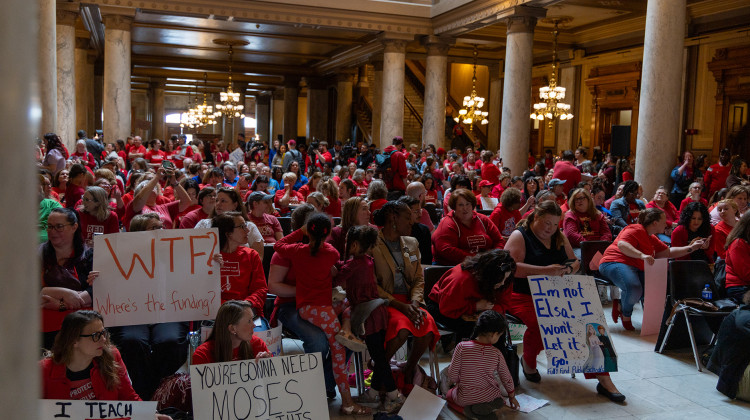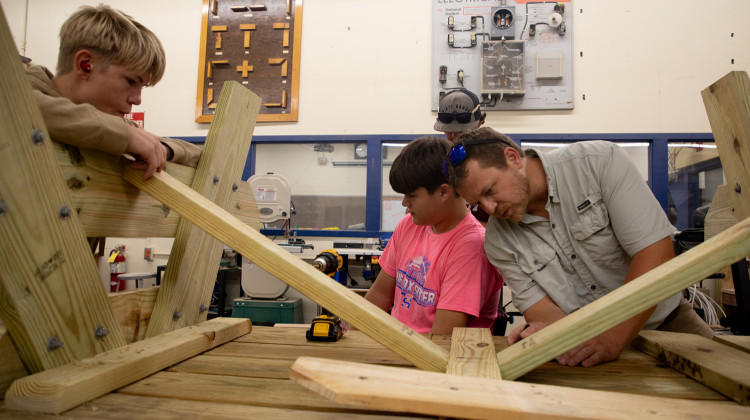
Roncalli High School in Indianapolis has 655 students using vouchers to help pay for tuition at the Catholic school. That's the most students among the 343 Indiana private schools in the taxpayer-funded voucher program.
NPR File PhotoParticipation in Indiana’s taxpayer-funded private school voucher program jumped to the highest level since its start over a decade ago – even as the number of low-income and families of color using vouchers decreased.
According to a new state report, the Choice Scholarship Program totaled $311.8 million in grants for 53,262 students in the 2022-23 academic year. That’s 9,000 students and $70.4 million more than the previous school year.
But those increases will be dwarfed over the next two years, as nearly all Indiana students will become eligible for vouchers in the coming weeks. Those changes, enacted by new state law, are estimated to qualify 41,800 additional students for the program and cost $1.136 billion in total.
DATABASE: How much private schools get in Indiana's voucher program
Vouchers were originally intended to help low-income students pay tuition at a private or religious school, and later aid those enrolled at failing schools. The idea was these students would then have the choice to attend a high quality private school. But there's been ongoing debate over the academic benefits of vouchers and the lack of access for some students, such as those with disabilities.
In 2013, Indiana’s Supreme Court upheld the use of public funds to support student tuition at private schools. Since then, state Republican lawmakers have consistently pushed for eligibility expansions to allow more students to use the program. During his term as governor, former Vice President Mike Pence expanded eligibility, including to middle class families, leading to a nearly three-fold increase of students receiving a voucher.
Then in 2021 lawmakers increased the income eligibility to $154,000 for a family of four — that’s 300 percent of federal free or reduced price lunch eligibility.
Now, in the program’s 12th year, the average student receiving a voucher is described as White, elementary school-age, and from a household of around four people with an income of $81,818, according to the Indiana Department of Education. Indiana's median household income is around $62,000.
The report found the high-income eligibility likely led to the 9.3 percent decrease in the number of participating families with an income of $50,000 or less. Families earning $100,001 to $150,000 saw the largest increase in voucher use at about 8.4 percent.
White students have always made up the majority of those in the voucher program. And they've steadily grown from 48 percent in the first year to nearly 62 percent now. In the last school year, the percentage of White students using vouchers grew by 3 percent, and Asian students ticked up by less than 0.25 percent.
All other racial groups declined or stayed the same: Hispanic students at 19 percent and Black students at 9.5 percent of the program.
Statewide, White students make up 66 percent of all students in public, private and charter schools.
Critics have long criticized the program for diverting taxpayer funds from public schools to private schools that are not required to follow many of the same transparency and reporting rules as traditional public or charter schools. Democrat lawmakers have failed to block vouchers going to private schools that discriminate against lesbian, gay, bisexual, and transgender students on the basis of religion.
Vouchers provide 90 percent of the amount of state-funding a public school corporation receives for each student, or covers tuition and fees – whichever is the lesser amount.
The two private schools with the most students and state funds in the voucher program are in Indianapolis: Roncalli High School with 655 students and $4,151,401; and Heritage Christian School with 606 students and $3,721,258.
Now, 4.68 percent of all Indiana students use a voucher to attend a school. Traditional public schools make up 87.47 percent of enrollment.
Contact WFYI education editor Eric Weddle at eweddle@wfyi.org or call (317) 614-0470. Follow on Twitter: @ericweddle.
 DONATE
DONATE






 Support WFYI. We can't do it without you.
Support WFYI. We can't do it without you.